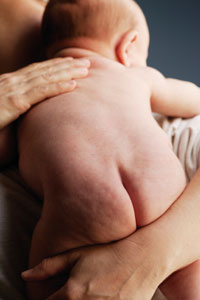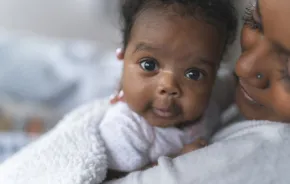You love your baby’s smooth, perfect skin … except sometimes it isn’t! Instead of oh-so-soft skin, many babies are plagued with dryness, rashes and other skin irritations.
First-time mom Teresa Pape is all too familiar with her baby's skin issues.  Pape’s 1-year-old son, Neil, suffers from periodic diaper rash and eczema. “It’s hard when you have a new baby and he is struggling with skin issues,” says the Lynnwood mom. “Now that we are treating the problems, it’s not a big deal, but in the moment, a baby's skin issues can be very concerning.”
Pape’s 1-year-old son, Neil, suffers from periodic diaper rash and eczema. “It’s hard when you have a new baby and he is struggling with skin issues,” says the Lynnwood mom. “Now that we are treating the problems, it’s not a big deal, but in the moment, a baby's skin issues can be very concerning.”
Recognizing common baby skin problems and knowing how to treat them can make your baby — and you! — more comfortable and less stressed.
Cradle cap
Babies with a scaly, dry scalp most likely have cradle cap. “Although we don’t know the cause, cradle cap is very common and will usually look better as the baby reaches 3 to 4 months of age,” says Dr. Pamela K. Moore, a pediatrician at Tacoma’s Mary Bridge Children’s Hospital. “It’s not necessary to treat, as it will resolve on its own.”
If you want to try to diminish the scales, Moore recommends putting baby oil on your infant's scalp and letting it soak in for 15 minutes. After the oil loosens the scales, brush them out with a soft baby brush. Then, wash the hair with a gentle baby shampoo. “You can repeat this treatment two to three times a week,” says Moore.
Diaper rash
Most babies will get at least one diaper rash during their infancy, and some are much worse than others. “The two main causes of diaper rash are irritation from urine and feces and the presence of yeast,” says Dr. Robin L. Hornung, the chief of pediatric dermatology at Children’s Hospital and Regional Medical Center.
The diaper rash irritation makes the baby's skin red — sometimes very red — and can be treated by applying a barrier protectant, such as Desitin, to the affected area after it is dry.
If the redness persists, you can use a topical cortisone ointment, says Dr. Hornung. If the condition should worsen, contact your pediatrician.
Yeast produces rapidly spreading red dots and occasional pustules. The yeast can be treated by using a topical anti-yeast cream such as Monistat or Nystatin 3 and keeping the affected area cool and dry.
Hornung advises avoiding baby wipes once redness appears. “Baby wipes usually contain chemicals and fragrances that add to the problem,” says Hornung. “Use a soft, newborn washcloth with water to clean the area.”
Baby acne
If your baby looks like she’s struggling with teenage skin, she probably suffers from baby acne. Moore describes baby acne as tiny whitehead pimples that predominantly appear on a baby’s forehead, nose, cheeks and chin. The acne usually develops around 2 weeks of age and lasts for a few weeks.
Baby acne is a result of hormones that are passed from mother to baby, and resolves on its own after the hormones taper off. “Baby acne looks a lot worse than it is; that’s why it is concerning to parents,” said Moore. “Just keep the baby’s face clean and dry, and know that it will go away.”
Eczema
Eczema usually appears around 2 months of age and starts with extremely itchy, red patches on the baby's cheeks, hands and feet.
Eczema is primarily caused by genetics, the immunological makeup of the skin and environmental factors. “Eczema is not caused by allergies, but sometimes allergies can trigger or exacerbate eczema,” Hornung says.
Hornung recommends treating eczema with over-the-counter barrier protectants. Use ointments instead of water-based creams or lotions that evaporate quickly. “The thicker and greasier, the better,” she says. “Your pediatrician may also prescribe a topical steroid to fight the inflammation.”
Many factors trigger a baby's eczema flare-ups, including extreme temperatures, infections or illness and scratching. “It’s a vicious cycle,” says Hornung. “A baby’s natural response is to itch and scratch their skin, which unfortunately keeps the eczema going.”
Avoiding soap at your baby's bath time also alleviates the itch. “Water is good for the skin; it is soap that’s the problem,” says Hornung. “Keep it simple.”
Mom knows best
If your instincts tell you that something’s not right with your baby’s skin, be proactive. Bring your concerns to your pediatrician. “Don’t be shy. Ask other moms at the park or at play group what they have done,” encourages Pape. “Everyone has been through it and can share their experience. What worked for them just might work for you.”
Keeping healthy skin healthy
Our experts offer a few tips for caring for normal, healthy baby skin:
- Limit baths to a couple of times a week. “Infants do not create much oil, and their skin can become dry and irritated if you bathe them daily,” Moore advises.
- Keep baby's skin care regimen simple. “If your child has normal skin, don't smear it with lotions and powders,” Hornung recommends. “There are so many baby care products on the market. You don't need to expose your child to all kinds of treatments and moisturizers.”
- Avoid products with colors and fragrances. “Baby skin is delicate, so find products without added colors and fragrances,” Moore says.
Abbey McGee is an Everett-based freelance writer and mother of two toddlers.
This article was originally published in the April, 2008 print edition of ParentMap.









